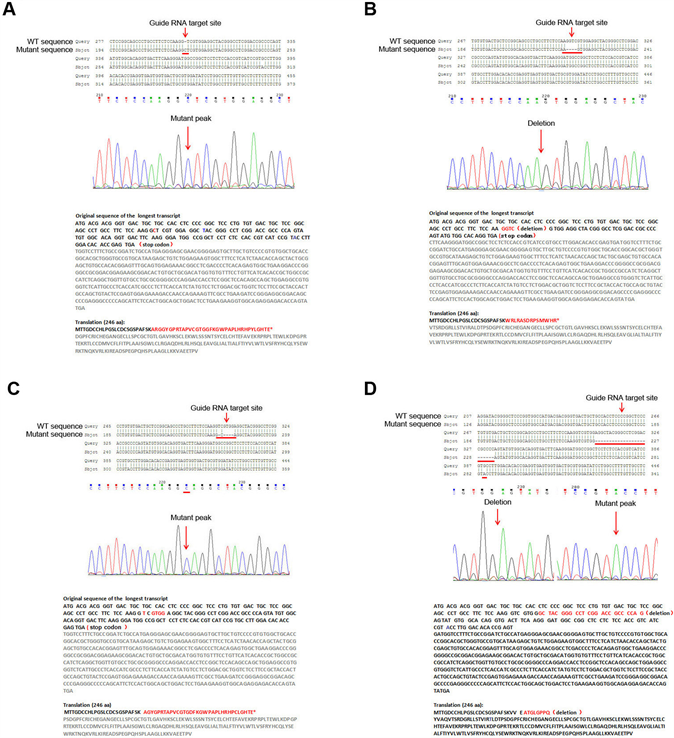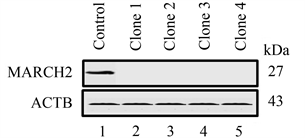Advances in Clinical Medicine
Vol.
09
No.
04
(
2019
), Article ID:
29521
,
7
pages
10.12677/ACM.2019.94058
Construction of MARCH2 KO Cell Line by CRISPR/Cas9 Technology
Dan Xia
Pathology Department of Shandong Medical College, Linyi Shandong

Received: Mar. 6th, 2019; accepted: Mar. 22nd, 2019; published: Mar. 29th, 2019

ABSTRACT
CRISPR/Cas9 system is the state-of-the-art genome-editing technology through constitutive expression of nucleases Cas9, which binds to a specific site in the genome mediated by single guide RNA (sgRNA) and induces double-strand breaks (DSBs) at desired genomic loci. DSBs induced by these site-specific nucleases can be repaired by error-prone nonhomologous end joining (NHEJ) or homologous recombination, to generate gene-specific knockout (KO) or knock-in cells. The membrane associated RING-CH (MARCH) family comprises a structurally related protein family. Currently, there are at least eleven known MARCH genes (MARCH-1–11) in the human genome. MARCH2 is involved in the regulation of vesicle trafficking, and thus refers to the formation, intracellular movement, exocytosis, and endocytosis of synaptic vesicles. In this study, two sgRNAs targeting the Exon2 of MARCH2 gene were designed, and their gene targeting efficiency was assessed via the western blot analyses. Through dilution plating, a monoclonal MARCH2 KO cell line was isolated and subjected to the sequence analysis, which revealed that it contained frameshift mutations in both MARCH2 alleles. The results obtained demonstrate the successful application of the CRISPR/Cas9 system to the construction of the MARCH2 KO cell line, and strongly suggest that it is a promising tool for studying the functions and related mechanisms of MARCH2.
Keywords:MARCH2, CRISPR/Cas9, Gene Knockout, Frameshift Mutation
应用CRISPR/Cas9基因编辑技术构建沉默MARCH2的细胞系
夏丹
山东医学高等专科学校病理教研室,山东 临沂

收稿日期:2019年3月6日;录用日期:2019年3月22日;发布日期:2019年3月29日

摘 要
CRISPR/Cas9系统是一种先进的基因编辑技术,人工设计先导RNA (single-guide RNA, sgRNA)介导外源表达的Cas9蛋白特异性的结合、切割基因组靶点,切割后的DNA有非同源末端连接(non-homologous end joining, NHEJ)和同源重组(homologous recombination)两种修复方式,以构建基因特异性敲除或敲入细胞。The membrane associated RING-CH (MARCH)家族由一系列结构相关的蛋白组成,目前,在人类基因组中至少有11个已知成员(MARCH-1–11)。MARCH2参与囊泡运输的调节,如突触囊泡的形成、细胞内运动、胞外分泌和内吞。在本研究中,我们针对MARCH2基因第二外显子设计了CRISPR/Cas9干扰靶序列,并应用蛋白质印迹方法对其基因剔除的有效性进行了验证,结果显示在两个MARCH2等位基因都含有移码突变,证实我们应用CRISPR/Cas9系统成功构建了MARCH2敲除的细胞系,这将是MARCH2功能及相关机制研究的强有力的工具。
关键词 :MARCH2,CRISPR/Cas9,基因敲除,移码突变

Copyright © 2019 by author(s) and Hans Publishers Inc.
This work is licensed under the Creative Commons Attribution International License (CC BY).
http://creativecommons.org/licenses/by/4.0/


1. 引言
CRISPR (clustered regularly interspaced short palindromic repeat)是一段串联重复序列,先后在原核生物大肠杆菌基因组中以及细菌和古细菌中发现CRISPR的存在,并且CRISPR具有抵御外来噬菌体入侵的功能 [1] [2] 。CRISPR中重复序列和间隔可变序列分别21~48 bp、21~72 bp,CRISPR基因座转录加工为成熟的crRNA。CAS基因定位在CRISPR基因座附近的区域,编码具有核酸酶和解旋酶活性的蛋白,与crRNA形成的蛋白核酸复合物可以识别DNA序列上的PAM (protospacer adjacent motif)区域,特异性切割DNA双链,发挥免疫防御功能 [3] [4] 。利用此特性可将其用作人工核酸内切酶,对基因组特定位点进行遗传修饰,精确编辑基因组 [5] 。CRISPR/Cas9系统就是基于此原理人为优化的基因组编辑系统,人工设计先导RNA (single-guide RNA, sgRNA)介导外源表达的Cas9蛋白特异性的结合、切割基因组靶点 [6] ,切割后的DNA有非同源末端连接(non-homologous end joining, NHEJ)和同源重组(homologous recombination)两种修复方式。在无外源的同源DNA存在时,切割的DNA可通过NHEJ连接结合,这样在切割位点就会引入插入或缺失序列,进而引发目的基因编码的蛋白产生移码突变以实现对目的基因的敲除。如果有同源片段存在,切割的DNA则发生同源重组,将外源片段整合到基因组中,以实现基因的敲除、敲入或突变等。
MARCH2 (membrane associated RING-CH protein 2)是MARCH家族成员之一,含有RING结构域,具有E3泛素连接酶活性,调节多种细胞活动如细胞运输、DNA修复和信号转导 [7] 。MARCH2作为跨膜泛素连接酶家族成员之一,近来被报道与病毒免疫逃逸蛋白有密切关系 [8] 。MARCH2最初的作用主要是通过与syntaxin 6 (STX6)相互作用参与囊泡运输 [9] 。泛素化过程被广泛称为蛋白的“死亡之吻”,因为如果将一个小分子泛素附在蛋白上,就会使此蛋白失去活性,这个小分子泛素就是一个标签,它向蛋白运输载体发出信号使其运输蛋白到蛋白酶体以降解之。作为E3泛素连接酶家族成员之一,MARCH2可以泛素化几种底物,如DLG1 [10] ,β2AR [11] ,和CFTR [12] 。
我们选用目前最先进CRISPR/Cas9基因编辑技术来构建稳定敲除MARCH2的细胞系作为MARCH2功能研究更有效的工具。
2. 材料和方法
2.1. 材料和试剂
兔抗人MARCH2多克隆抗体购自美国Abcam公司;ACTB/b-actin抗体购自Tianjin Sungene公司;Megatran 1.0转染试剂购自Biotum公司;细胞和组织基因组DNA提取试剂盒购自华中海威公司;PX330-MARCH2-sgRNA质粒购自上海南方模式生物科技发展有限公司;MARCH2 DNA引物购自Invitrogen公司。
2.2. 合成sgRNA寡核苷酸序列并构建载体
由上海南方模式生物科技发展有限公司设计CRISPR干扰靶序列,并针对人类的MARCH2基因构建CRISPR-Cas9表达载体。
Guide RNA靶序列如下:
Guide RNA target site 1:GCCCGTAGCCTCCACGACCTTGG
Guide RNA target site 2:TCCAAGGTCGTGGAGGCTACGGG
载体构建:载体PX330-GFP使用Bbs I酶切电回收,分别与MARCH2-V-Gui-F/R,MARCH2-V-Gui-F2/R2退火产物连接转化,涂布于氨苄平板上,37℃培养过夜。次日,分别挑取3个单克隆,使用引物u6-gui-id-f测序。
质粒纯化:测序正确的克隆接种4 ml LB,使用QIAGEN Plasmid Midi Kit抽提质粒,溶于Nuclease-Free Water中,−30℃保存待用。
2.3. PX330-MARCH2-sgRNA质粒转染细胞
正常培养HCT116细胞至密度为60%~70%,用Megatran 1.0作为转染试剂,将质粒PX330-MARCH2-1-sgRNA和PX330-MARCH2-2-sgRNA转染细胞。在荧光显微镜下观察发现,转染了PX330-MARCH2-sgRNA的细胞多数表达绿色荧光,表明质粒转染细胞成功。
2.4. 单克隆筛选、DNA提取及PCR
细胞转染PX330-MARCH2-sgRNA质粒后,正常培养48小时后,收细胞,进行流式分选,铺96孔板,每孔一个细胞。待2周左右,单个细胞长成克隆时,显微镜下仔细观察每一个孔的细胞,若发现非单克隆的细胞需要将其标注出来剔除筛选之外。传两代后,取出单个克隆的一部分细胞提取基因组DNA。按照试剂盒操作步骤进行操作,以2 μl DNA作为模板进行PCR扩增,送公司测序及分析。MARCH2 DNA的上游引物为5’-AGA TGG TGC AAA CTG AGG CT-3’,下游引物5’-AAC TAG CCA GGT GTG GTG AC-3’ [13] 。
2.5. Western blot鉴定
为检测CRISPR/Cas9系统对内源基因表达水平的影响,将测序结果为阳性单克隆的细胞培养48 h后,收取蛋白样品进行Western blot检测。比较野生型HCT116细胞与转染Cas9-MARCH2质粒的细胞的MARCH2蛋白表达水平,鉴定利用CRISPR/Cas9系统敲除细胞内源MARCH2的效率。
3. 结果
3.1. 应用CRISPR/Cas9基因编辑技术构建沉默MARCH2的细胞系
CRISPR/Cas9系统通过引进插入或缺失可以精确敲除靶基因,为观察缺失整个蛋白后的表型提供必要工具。为了进一步证实MARCH2的功能,我们应用CRISPR/Cas9基因编辑技术构建敲除MARCH2基因的HCT116细胞系。我们针对MARCH2基因第二外显子设计的CRISPR/Cas9干扰靶序列为TCC AAG GTC GTG GAG GCT ACG GG,通过载体构建、质粒纯化、转染、流式分选、单克隆培养、测序、分析、鉴定得到了敲除MARCH2基因的细胞系。
经过一系列克隆筛选,我们得到了4个Cas9-MARCH2克隆。序列分析显示这些突变大多导致移码,提前出现终止密码子(TGA),翻译提前终止使得MARCH2的RING domain和PDZ domain缺失,不能行使其功能(图1A~D)。简单描述这些突变如下:克隆1:GT → GCT;克隆2:AGGTCG → AG;克隆3:TCGTGG → C;克隆4:缺失性突变(No. 28~35 GCTACGGGCCTCGGACCGCCCCAG)和点突变(No. 54 GCC → ACC)。
3.2. 沉默MARCH2的细胞系的Western blot鉴定
Western blot鉴定结果显示,CRISPR/Cas9靶向敲除MARCH2导致MARCH2蛋白表达水平消失(图2)。
4. 讨论
基因编辑技术是基因功能研究的工具。早期,同源重组技术用于基因编辑,但效率非常低。人工核苷酸技术的出现提高了基因编辑的效率。除了CRISPR/Cas9系统之外,人工核苷酸系统也包括锌指核苷酸zinc finger nuclease (ZFN)和激活转录因子效应核酶activating transcription factor effector nuclease (TALEN) [14] 。ZFN和TALEN通过DNA蛋白识别特异靶点:ZFN上的锌指结构单元能识别三个基本序列;TALEN通过重复可变区repeat variable diresidue (RVD)能识别特异碱基,根据ZFN结构或RVD组合,可以设计分子蛋白结合任何基因组中的DNA序列,因而能识别并剪切特异的DNA序列 [15] [16] 。CRISPR/Cas9系统是蛋白和核酸组成的蛋白核酸复合体,应用先导RNA识别DNA序列 [17] [18] 。因此,Cas9蛋白被用于切割靶序列。基因组的大小决定靶标DNA序列通常超过10 bp。因而,ZFN或TALEN系统必须依赖ZFN蛋白单位的目的序列或RVD排列和组合,使得质粒构建过程耗时费力。同时,CRISPR/Cas9系统的识别依赖单导RNA和目的DNA的碱基互补配对,只需要23 bp大小的单导RNA对应不同的靶标即可,这样显著简化了质粒构建的任务。
在CRISPR/Cas9基因编辑技术出现之前,细胞水平基因功能研究主要依靠RNA干扰技术,为基因功能和机制的分析提供了不小帮助。然而,RNA干扰的短暂性和不完全性可能影响基因功能的正确判断。CRISPR/Cas9技术在基因水平上能引起移码框突变,因此,目的基因被敲除。它是比RNA干扰技术更有效的研究基因功能的工具。在近来的研究报道中,通过CRISPR/Cas9全基因组文库进行的黑色素瘤耐药基因的筛选提供了RNA干扰文库相关的这些基因的成功识别 [19] 。
MARCH2是二次跨膜蛋白,由N端RING domain中间的二次跨膜区和C端的PDZ domain构成。已有功能研究证明,MARCH2是高尔基体和内体之间运输的调节分子 [9] ,MARCH2作为E3连接酶能降解细胞表面受体如转铁蛋白受体(TfR, transferrin receptor)和共刺激分子B7.2 (CD86),能与β2AR相互

Figure 1. MARCH2 CRISPR/Cas9 KO sequence diagram. A: Clone 1 sequence diagram, GT → GCT; B: Clone 2 sequence diagram, AGGTCG → AG; C: Clone 3 sequence diagram, TCGTGG → C; D: Clone 4 sequence diagram, deletion mutation (No. 28~35 GCTACGGGCCTCGGACCGCCCCAG) and point mutation (No. 54 GCC → ACC)
图1. CRISPR/Cas9敲除MARCH2基因序列图A克隆1的序列图GT → GCT;B:克隆2的序列图AGGTCG → AG;C:克隆3的序列图TCGTGG → C;D:克隆4的序列图,缺失性突变(No. 28~35 GCTACGGGCCTCGGACCGCCCCAG)和点突变(No. 54 GCC → ACC)

Figure 2. The endogenous expression of MARCH2 protein in Cas9-MARCH2 cells were detected by the Western blot
图2. Western blot检测Cas9-MARCH2细胞的内源性MARCH2表达
作用,促进β2AR的内吞和溶酶体降解 [11] 。MARCH2也能定位在HEK293T细胞细胞膜上,通过其PDZ motif与DLG1 (discs large homolog 1, scribble cell polarity complex component)相互作用促进DLG1泛素化,减弱DLG1在细胞连接点的表达,影响细胞的极性 [10] 。最近的研究发现,在CFBE细胞(囊性纤维化支气管上皮细胞,Cystic fibrosis bronchial epithelial cell line)中MARCH2通过与CAL (CFTR相关的配体)和STX6结合泛素化并降解CFTR [12] 。MARCH2在HIV-1感染中表达升高,通过包膜蛋白易位和降解抑制HIV-1产物,在监管和调节HIV-1感染相关的过程中发挥举足轻重的作用 [20] [21] 。我们前期的研究发现MARCH2参与了肿瘤的发生和进展,但其作用机制尚不清楚,本研究应用先进的CRISPR/Cas9基因编辑技术成功建立沉默MARCH2的细胞系,将为MARCH2的功能和机制的研究提供有效的工具。
基金项目
本研究由国家自然科学基金项目(81702776);山东省高等学校科技计划项目(J17KA238);山东省医药卫生科技发展计划项目(2016WS0569)资助。
文章引用
夏 丹. 应用CRISPR/Cas9基因编辑技术构建沉默MARCH2的细胞系
Construction of MARCH2 KO Cell Line by CRISPR/Cas9 Technology[J]. 临床医学进展, 2019, 09(04): 383-389. https://doi.org/10.12677/ACM.2019.94058
参考文献
- 1. Ishino, Y., et al. (1987) Nucleotide Sequence of the iap Gene, Responsible for Alkaline Phosphatase Isozyme Conver-sion in Escherichia coli, and Identification of the Gene Product. Journal of Bacteriology, 169, 5429-5433. https://doi.org/10.1128/jb.169.12.5429-5433.1987
- 2. Barrangou, R., et al. (2007) CRISPR Provides Acquired Resistance against Viruses in Prokaryotes. Science, 315, 1709-1712. https://doi.org/10.1126/science.1138140
- 3. Deveau, H., Garneau, J.E. and Moineau, S. (2010) CRISPR/Cas System and Its Role in Phage-Bacteria Interactions. Annual Review of Microbiology, 64, 475-493. https://doi.org/10.1146/annurev.micro.112408.134123
- 4. Kunin, V., Sorek, R. and Hugenholtz, P. (2007) Evo-lutionary Conservation of Sequence and Secondary Structures in CRISPR Repeats. Genome Biology, 8, R61.
- 5. Hwang, W.Y., et al. (2013) Efficient Genome Editing in Zebrafish Using a CRISPR-Cas System. Nature Biotechnology, 31, 227-229. https://doi.org/10.1038/nbt.2501
- 6. Mali, P., Esvelt, K.M. and Church, G.M. (2013) Cas9 as a Versatile Tool for Engineering Biology. Nature Methods, 10, 957-963. https://doi.org/10.1038/nmeth.2649
- 7. Bartee, E., et al. (2004) Downregulation of Major Histocompatibility Complex Class I by Human Ubiquitin Ligases Related to Viral Immune Evasion Proteins. Journal of Virology, 78, 1109-1120. https://doi.org/10.1128/JVI.78.3.1109-1120.2004
- 8. Boutell, C., Sadis, S. and Everett, R.D. (2002) Herpes Simplex Virus Type 1 Immediate-Early Protein ICP0 and Is Isolated Ring Finger Domain Act as Ubiquitin E3 Ligases in Vitro. Journal of Virology, 76, 841-850. https://doi.org/10.1128/JVI.76.2.841-850.2002
- 9. Nakamura, N., et al. (2005) MARCH-II Is a Syntax-in-6-Binding Protein Involved in Endosomal Trafficking. Molecular Biology of the Cell, 16, 1696-1710. https://doi.org/10.1091/mbc.e04-03-0216
- 10. Cao, Z., et al. (2008) DLG1 Is an Anchor for the E3 Ligase MARCH2 at Sites of Cell-Cell Contact. Cell Signal, 20, 73-82. https://doi.org/10.1016/j.cellsig.2007.08.019
- 11. Han, S.O., et al. (2012) MARCH2 Promotes Endocytosis and Lysosomal Sorting of Carvedilol-Bound Beta(2)-Adrenergic Receptors. The Journal of Cell Biology, 199, 817-830. https://doi.org/10.1083/jcb.201208192
- 12. Cheng, J. and Guggino, W. (2013) Ubiquitination and Degradation of CFTR by the E3 Ubiquitin Ligase MARCH2 through Its Association with Adaptor Proteins CAL and STX6. PLoS ONE, 8, e68001.
- 13. Bauer, D.E., et al. (2015) Generation of Genomic Deletions in Mammalian Cell Lines via CRISPR/Cas9. Journal of Visualized Experiments, 95, e52118.
- 14. Mussolino, C. and Cathomen, T. (2013) RNA Guides Genome Engineering. Nature Biotechnology, 31, 208-209. https://doi.org/10.1038/nbt.2527
- 15. Geurts, A.M., et al. (2009) Knockout Rats via Embryo Microinjection of Zinc-Finger Nucleases. Science, 325, 433.
- 16. Cermak, T., et al. (2011) Efficient Design and Assembly of Custom TALEN and Other TAL Effector-Based Constructs for DNA Targeting. Nucleic Acids Research, 39, e82.
- 17. Cong, L., et al. (2013) Multiplex Genome Engineering Using CRISPR/Cas Systems. Science, 339, 819-823. https://doi.org/10.1126/science.1231143
- 18. Mali, P., et al. (2013) RNA-Guided Human Genome Engineering via Cas9. Science, 339, 823-826. https://doi.org/10.1126/science.1232033
- 19. Mandal, P.K., et al. (2014) Efficient Ablation of Genes in Human Hematopoietic Stem and Effector Cells Using CRISPR/Cas9. Cell Stem Cell, 15, 643-652. https://doi.org/10.1016/j.stem.2014.10.004
- 20. Zhang, Y., et al. (2018) MARCH2 Is Upregulated in HIV-1 In-fection and Inhibits HIV-1 Production through Envelope Protein Translocation or Degradation. Virology, 518, 293-300.
- 21. Zhang, Y., et al. (2019) Membrane-Associated RING-CH (MARCH) 1 and 2 Are MARCH Family Members That Inhibit HIV-1 Infection. The Journal of Biological Chemistry, 294, 3397-3405.